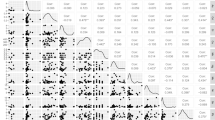Abstract
The concentrations of the essential trace elements Cu, Fe, and Zn, and of the mineral elements Ca, K, Mg, and P during the perinatal period in human placenta and in the blood of the mother and the newborn (cord blood) were determined. Breast milk (colostrum and transitory milk) was also included to permit correlations between the different compartments. No correlations were found. The uptake by nutrition and the body-pools of the mother and their mobilization for these elements seem to be sufficiently high for an adequate supply of the fetus and the milk in the geographical region of Munich (Bavaria, FRG) under these investigations. Differences in the mineral- and trace element concentrations of colostrum and transitory milk for the elements P and Zn and to a lesser extent for Ca and Mg were observed. Additionally, breast milk samples from different geographical regions in Bavaria were investigated. Results for the heavy metals Cd, Hg, and Pb, and for the essential trace element Se are also presented for these samples, and can be seen as a reflection of the overall environmental and dietary influences during pregnancy in these geographical regions. ICP (Inductively Coupled Plasma)-emission spectrometry was used for the determination of the elements Cu, Fe, Zn, Ca, K, Mg, and P. For the additionally given elements in the milk-samples anodic stripping voltammetry (DPASV) (Cd, Pb), hydride atomic absorption spectrometry (AAS) (Se), and cold vapor AAS (Hg) were applied.
Similar content being viewed by others
References
R. Thieme, P. Schramel, B.-J. Klose, and E. Waidl,Geburtsh. u. Frauenheilk. 34, 36–41 (1974).
R. Thieme, P. Schramel, B.-J. Klose, and E. Waidl,Geburtsh u. Frauenheilk. 35, 349–353 (1975).
R. Thieme, P. Schramel, and E. Kurz,Geburtsh. u. Frauenheilk. 37, 756–761 (1977).
R. Thieme, P. Schramel, and G. Keiler,Geburtsh. u. Frauenheilk. 46, 180–184 (1986).
R. Thieme, B.-J. Klose, P. Schramel, and K. Samsahl,Geburtsh. u. Frauenheilk. 33, 652–661 (1973).
P. Schramel, A. Wolf, R. Seif, and B.-J. Klose,Fresenius Z. Anal. Chem. 302, 62–64 (1980).
P. Schramel, G. Lill, and S. Hasse,J. Clin. Chem. Clin. Biochem. 23, 293–301 (1985).
P. Schramel, S. Hasse, and G. Knapp,Fresenius Z. Anal. Chem. 326, 142–145 (1987).
S. Hasse and P. Schramel,Mikrochimica Acta III, 449–455 (1983).
P. Schramel, S. Hasse, and J. Ovcar-Pavlu,Biol. Trace Element Res. (in press).
H.-B. v. Stockhausen, InTrace Element Analytical Chemistry in Medicine and Biology, vol. 4, 61–78 (Brätter, P., and Schramel, P., eds.), Verlag W. de Gruyter, Berlin (1987).
M. J. Danncey, J. C. L. Shaw, and J. Urman,Pediatr. Res. 11, 991–997 (1977).
A. Higashi, I. Matsuda, T. Masumoto, H. Saikusa, M. Yabuso, and Y. Oka,Tohoku. J. Exp. Med. 146, 253–263 (1985).
P. Schramel, unpublished.
M. S. Tanner, A. H. Kanterjian, S. A. Bhave, and A. N. Pandit,Lancet 2, 992–995 (1983).
L.-O. Plantin and S. Meurling, InTrace Element Analytical Chemistry in Medicine and Biology, vol. 1, 243–254 (Brätter, P., Schramel, P., eds.), Verlag W. de Gruyter, Berlin (1980).
I. Lombeck, K. Kasparek, L. E. Feinendegen, and H. J. Bremer, InSpurenelemente in der Entwicklung von Mensch und Tier, 149–158, (Bidlingmaier, E., eds.), Urban und Schwarzenberg, München (1975).
J. Müller, S. Götze, V. Negretti De Brätter, P. Weigert, G. Korkat, A. G. Hildebrandt, and P. Brätter,ZEBS-Hefte,1, 1–79 (1986).
K. R. Machan, In:Trace Element Analytical Chemistry in Medicine and Biology, vol. 3, 323–329 (Brätter, P., Schramel, P., eds.), Verlag W. de Gruyter, Berlin (1984).
E. Roekens, H. Deelstra, and H. Robberecht,Sci. of the Tot. Env. 42, 91–108 (1985).
K. M. Hambidge, InTrace Element Analytical Chemistry in Medicine and Biology, vol. 2, 3–18 (Brätter, P., Schramel, P. eds.) Verlag W. de Gruyter, Berlin (1983).
World Health Organization Technical Report Series No. 532, Trace Elements in Human Nutrition, Geneva (1973).
E. J. Underwood,Trace Elements in Human and Animal Nutrition, 4th ed., Academic, New York (1977).
K. M. Hambidge,J. Current Med. Res. and Opinion 4, 44–53 (1976).
Recommended Dietary Allowances, The National Research Council, 9th ed., Washington DC (1980).
Author information
Authors and Affiliations
Rights and permissions
About this article
Cite this article
Schramel, P., Lill, G., Hasse, S. et al. Mineral- and trace element concentrations in human breast milk, placenta, maternal blood, and the blood of the newborn. Biol Trace Elem Res 16, 67–75 (1988). https://doi.org/10.1007/BF02795335
Received:
Accepted:
Issue Date:
DOI: https://doi.org/10.1007/BF02795335



